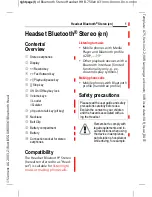
A920:
GSM RX Front End
Description
The EGSM, PCS and DCS signals must first pass through baluns before reaching the LIFE IC. Since the LIFE expects differential inputs, the baluns will provide this.
Baluns provide the change from an unbalanced to a balanced line condition. By directly connecting to lines together, a possibility might arise where one line might
ground a signal and impair the operation of a circuit. This situation is solved through the use of an un-balanced to balanced transformer, a balun. Expected nominal loss-
es is ~.5 - 1.0dBm.
The first IC in the EGSM, DCS, and PCS RX line up is U625 (LIFE), which is an LNA, VCO, and down converter mixer. The RX frequency is mixed down to a Very
Low Intermediate Frequency (VLIF) of ~ 100KHz. This design is utilized to improve LO leakage causing RF self-mixing, DC offsets, and noise performance. The LIFE
IC operates from the MAGIC_LV (tracking regulator), MAGIC_RF_V2_475. and MAGIC_SF (isolated supply for the VCO).
LIFE is comprised of four low noise amplifiers (three of which are used) with two quadrature mixer paths for use in receive GSM 900 (925- 960MHz), DCS (1805-
1880MHz), and PCS (1930-1990MHz) frequency bands, all SPI programmable. The RX_VCO signal is fed back to the MAGIC_LV prescaler input. Although the fre-
quency will be dependent of the channel selected, the amplitude signal is ~30dBm.
LIFE contains three fully contained VCOs which operate at ~4GHz. These VCOs are internally divided to provide precise quadrature down conversion for the three
frequency bands. The input signal RX_VTUNE from the RX backend processor (MAGIC_LV) selects the VCO frequency to operate at. The tune range is .5 - 4.5V.
The VCO frequencies for the three technologies are: DCS 3610 - 35759MHz, EGSM 3700 - 3838MHz, and PCS 3859 - 3980MHz.
The AGC is provided by a common amplifier section, which is shared by all four LNAs. The AGC amplifier gain control is controlled by the voltage on the AGC pin,
utilizing the internal 6-bit D/A to set the AGC via the SPI lines (SPIDATA, SPI_CLK, and SPI_CE). LIFE has an internal RF detector at the input of the AGC amplifier.
The detected DC output level will be compared against a reference, which corresponds to the maximum safe input level to the mixer. This reference is SPI selectable so
that the threshold can be set to 0dB, 3dB, 6dB, or 9dB below the level, which results in the mixer malfunction. If the detected level is above the reference then
AGC_FLAG will go high. The MAGIC_LV will receive this signal as an interrupt and will reprogram the AGC until the level drops below the safe mixer input level as
signified by AGC_FLAG returning low.
The output signals I / IX and Q / QX are @ ~100KHz IF value for the Very Low IF. The input pin, RX_EN_LIFE controls the on / off state of the receiver and the PLL
circuits. For input amplitude at the antenna of -50 to -40dBm the expected nominal output should be an AC rms peak-to-peak voltage of ~4.5 - 14mV.
Motor
o
la
Conf
ide
n
tia
l Pr
opr
ie
ta
ry
4-
4
RF
DET
RF
DET
RX_Q+
RX_Q-
RX_I+
RX_I-
GSM_RX
DCS_RX
PCS_RX
T660
T670
SPI
AUX_SPI_CLK
RX_EN_LIFE
LIFE_CE
AUX_SPI_DATA
÷2
÷2 or 4
GSM
PCS
DCS
÷5 or 3
RX_VCO
RX_VTUNE
LP
Filter
MAGIC
T650
MAGIC
U625
LIFE
















































